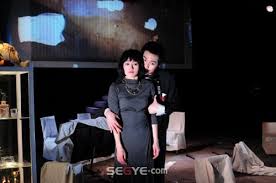Writer : William Shakespeare, Director : Alexander Zeldin, Stage designer : Samal Black
Macbeth’s conflict against winds
Macbeth’s monologue is the dialogue against the storm. I gave three voices to the winds, which means wind has three tracks on the mixer. An operator of sound should be an actor and struggle with Macbeth.

Macbeth v.s. Evil
He has many monologues in this play, which we can say dialogue against the destiny or the nature of this world.
Evil
Too Evil

Contents
“lullaby in bed room and battlefield”
Lullaby for all need to sleep, mainly for Child Macbeth
Lady Macbeth consoles Macbeth. But she also gets madness and kill herself. After the rains of sorrow, a time to sleep comes. From the bed room to the battle field, until the owl scream, the theater is filled with a voice of lullaby. There is a critical direction in the series of the scenes. Lullaby flows slowly but actors speak independently from the tempo of lullaby and actors without Macbeth move slowly. The stage is filled with the power of the great contrast.
Thus, actors and sound go together, otherwise we lost our precious moment.

Requiem
After Macbeth speaks at the end of the play, how the world changed? Nothing changed? How we close a story of a walking shadow and open the next play named “Tomorrow”? Can we find a remedy in the theater filled with sound?
Tempos
At a moment, sound follows an actor; the que is an actor. At another moment, an actor follows sound; the cue is music. The theatre is the ensemble of all breathes on the stage. Sound helps the all breath plays together.
In the case, the tempo of some sounds is the same as that of an actor’s breath, so that sound is synchronized with and activate an actor’s acting like harmony in music.In another case, sound appears in the different tempo from acting, so that the conflict amplifies the energy for acting like contrast in the picture.